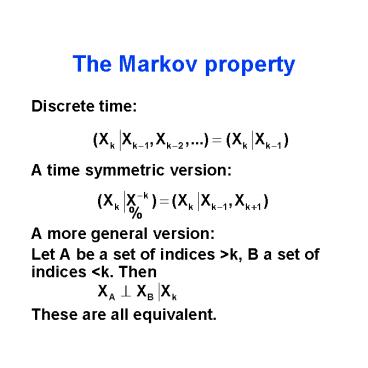The Markov property - PowerPoint PPT Presentation
1 / 11
Title:
The Markov property
Description:
Nearest neighbor potentials. A set of points is a clique if all its members are neighbours. ... Any nearest neighbour potential induces a Markov random field: ... – PowerPoint PPT presentation
Number of Views:107
Avg rating:3.0/5.0
Title: The Markov property
1
The Markov property
- Discrete time
- A time symmetric version
- A more general version
- Let A be a set of indices gtk, B a set of indices
ltk. Then - These are all equivalent.
2
On a spatial grid
- Let ?i be the neighbors of the location i. The
Markov assumption is - The pi are called local characteristics. They are
homogeneous if pi p. - A potential assigns a number VA(z) to every
subconfiguration zA of a configuration z.
3
Gibbs measure
- The energy U corresponding to a potential V is
. - The corresponding Gibbs measure is
- where
- is called the partition function.
4
Nearest neighbor potentials
- A set of points is a clique if all its members
are neighbours. - A potential is a nearest neighbor potential if
VA(z)0 whenever A is not a clique.
5
Markov random field
- Any nearest neighbour potential induces a Markov
random field - where z agrees with z except possibly at i, so
VC(z)VC(z) for any C not including i.
6
The Hammersley-Clifford theorem
- Assume P(z)gt0 for all z. Then P is a MRF on a
(finite) graph with respect to a neighbourhood
system ? iff P is a Gibbs measure corresponding
to a nearest neighbour potential. - Does a given nn potential correspond to a unique
P?
7
The Ising model
- Model for ferromagnetic spin (values 1 or -1).
Stationary nn pair potential V(i,j)V(j,i)
V(i,i)V(0,0)v0 V(0,eN)V(0,eE)v1. - so where
8
Interpretation
- v0 is related to the external magnetic field (if
it is strong the field will tend to have the same
sign as the external field) - v1 corresponds to inverse temperature (in
Kelvins), so will be large for low temperatures.
9
Phase transition
- At very low temperature there is a tendency for
spontaneous magnetization. - For the Ising model, the boundary conditions can
affect the distribution of x0. - In fact, there is a critical temperature (or
value of v1) such that for temperatures below
this the boundary conditions are felt. - Thus there can be different probabilities at the
origin depending on the values on an arbitrary
distant boundary!
10
Simulated Ising fields
11
Tomato disease
- Data on spotted wilt from the Waite Institute
1929. 16 plots in 4x4 Latin square, each 6 rows
with 15 plants each. Occurrence of the viral
disease 23 days after planting.































